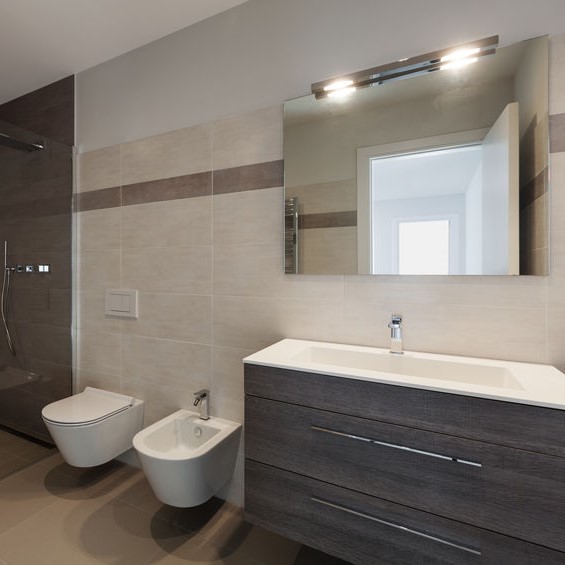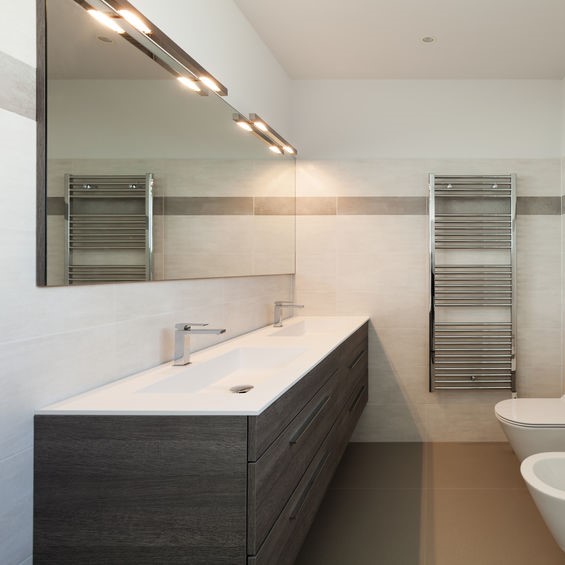
Professional mirror hanging
Mirror, mirror on the wall, how do you hang there so strong and tall? Ahhh, that would be by professional mirror installation service! Yes, there is such a thing as professional mirror installation for those mirrors that are framed, heavy, and/or large in size.
Why would you hire a mirror installation company to hang your mirror? Because there are mirrors that are more than just a basic mirror, you can hang on a wall yourself. Some mirrors come from various shapes, sizes, and weights that the basic nail or picture hanger can hold. These professional mirror installation crews hang mirrors in businesses and homes that cover an entire wall. Or a heavy, special cut framed or unframed mirror.
If you were to purchase a 5-foot square, frameless mirror for your bathroom renovation job, would know how much weight can drywall hold without a stud? Professional mirror installation services are done by crews that have been trained on knowing exactly how much weight drywall with or without studs can hold. Why is this important? So the 5-foot square mirror doesn’t fall and break!
The amount of weight you can put on drywall depends on exactly how much the mirror, or any object, weighs. Even a lightweight mirror with a lightweight frame can fall off when nothing more than a basic nail is used. The untrained person takes a hit or miss chance at doing their own mirror installation. Getting it to hang straight and safely, especially a heavy mirror, isn’t an easy task.
When you hire a mirror installation service, the technician will know what hardware and technique will hold your mirror. Whether it is a 5 pound or 100 pounds framed mirror, they have the experience, knowledge, and skills.
How do you attach a frameless mirror to the wall?
To do a frameless mirror installation on a wall, whether it is a large wall mirror installation or a unique oval mirror, takes a certain technique. If hiring a professional mirror installation service isn’t feasible, or you want to do it yourself, the following steps will guide you through the process so that your mirror installation is safe and secure.
Step One: Identify the Spot and Mark It
Select the specific spot that your new mirror will look its best. Mark the bottom corners and top corners of the mirror while holding it up in that spot, using a pencil or marker. With a heavy mirror or large mirror, enlist some help to hold the mirror or mark the corners. Choose a good sturdy type of clip, and if the mirror is large and heavy, use a Z-clip.
Step Two:. Check the Spot to Be Flat
Ensure the area you want your mirror installation is flat so that the clip will be secure to the wall and the mirror. You can verify this by sliding something flat and straight over the area. If there are bumps, you can make sure your mirror installation is between the bumps or find another area.
Step Three: Get it Straight
To get the mirror installation straight, you need exact measurements, using a level, and mark the spots for the clips.
Step Four: Find and Mark the Stud Edges
Most interior walls have wall studs that are evenly spaced. Using a stud finder or tap along the wall until you hear a solid sound to locate the studs. Then mark the two sides of each stud in the area of your mirror installation. Stand back and observe where these marks will place the mirror and make any adjustments if needed.
Step Five: Drill Pilot Holes
Using a power drill, make pilot holes for the plastic wall anchors and hammer them in flush with the wall. Then install the bottom clips.
Step Six: Mark the Top Clip Placement
Place the level vertically on the bottom clip and draw a line upward from each bottom clip so that is is aligned with the top edge of the mark you made for the mirror and mark the next set of pilot holes.
Step Eight: Drill the Top Pilot Holes
Now drill the top pilot holes you have marked, using the plastic wall anchors to level them if they are off a little. Hammer them in until wall flushed. Screw the top clips into the hole.
Step Eight: The Last Step
Carefully slide the mirror into the bottom clips and slowly tilt the mirror toward the wall until flush with the wall. Now, fit top clips into the top brackets and fasten them together with the screws provided so that mirror is firmly in place.
Notes: By doing this mirror installation yourself, you’ve saved money, but if you break or crack the mirror in the process, you have no recourse other than buying another mirror. By hiring a professional mirror installation service, they take all responsibilities.
Are mirror clips necessary?
Mirror clips and channel tracks are two common techniques for mirror installation, both are valid, and both are used by glass and mirror installation professionals. There are some circumstances where one is better than the other, and having a clear understanding of these two will help you determine which technique is best for mirror installation in your business or home.
Mirror clips:
- Securely but temporary
- For curved edges and no hanging brackets
L-bar:
- Straight edges and not resting on a permanent facade
- For a frameless look without obvious metal elements
Use J-channel:
- Straight edges and will not resting on a permanent facade
- A thin metal strip along the lower edge is desired
How much weight can mirror clips hold?
Mirror installation clips are available in any big box home improvement stores. A typical package will have four pieces and will state on the package the weight limit. A package that states 20 lb. shouldn’t be used for a mirror or any wall hanging that exceeds that weight limit.

How do you hang a heavy mirror without a stud?
Of course, the preferred method for mirror installation is into wall studs. Unfortunately, studs are rarely in the places you would like to install your mirror. In that case, hollow-wall anchors, or more commonly referred to as molly bolts, are excellent. Hollow-wall anchors or molly bolts come in different sizes and styles that can be used on any wall, including drywall or plaster, even a hollow concrete block. The different types of hollow-wall anchors are:
- Expandable Metal Anchors
- Wall Claw Anchors
- Toggle Bolts
- Self-Drilling Drywall Anchors
A mirror installation in bathrooms may be one of the trickiest installations next to full wall mirrors. These are the mirror installations best left to the professionals as they are the most vulnerable to causing injury or more damage than just to the mirror. Call 817-937-6267 today for your mirror installation in Fort Worth, TX.
